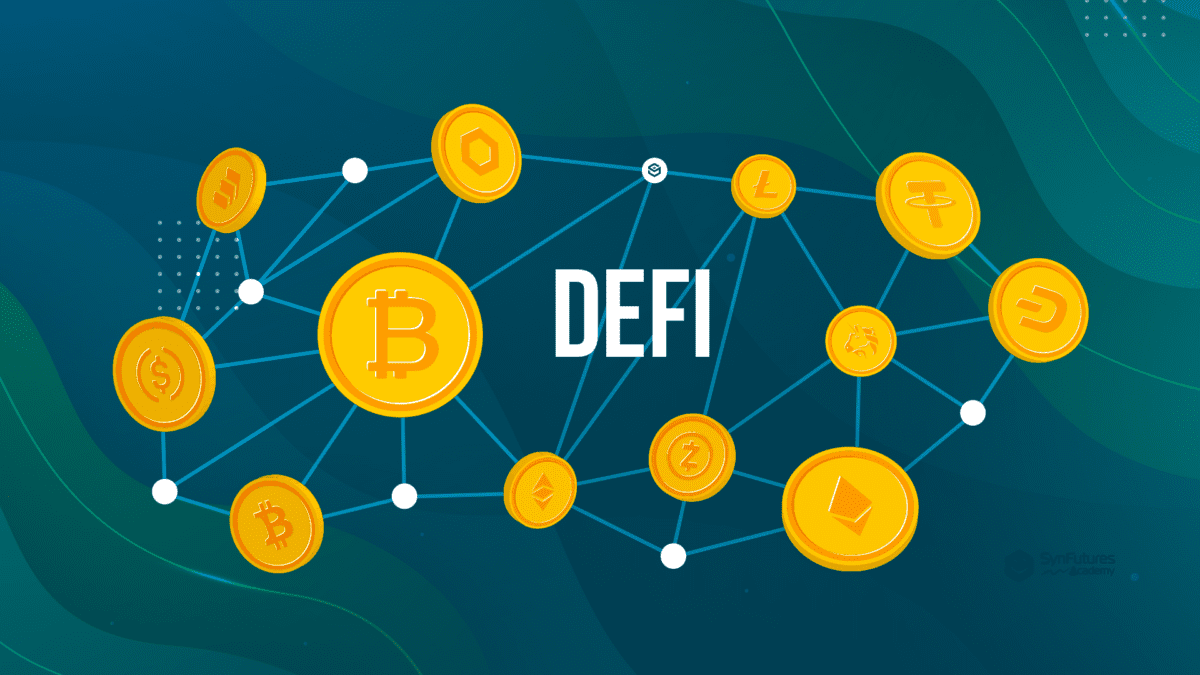Top 3 DeFi Milestones Of 2023 That Will Change The Trajectory Of The Future

DeFi, or Decentralized Finance, milestones refer to significant achievements or developments within the decentralized finance ecosystem. These milestones mark key points in the evolution and growth of DeFi, showcasing advancements, innovations, and broader adoption within the decentralized financial space. Some notable DeFi milestones include:
- Introduction of Ethereum Smart Contracts:
- The launch of Ethereum and its ability to support smart contracts in 2015 laid the foundation for decentralized finance. Smart contracts enable programmable and self-executing agreements, allowing the creation of various financial applications.
- Creation of MakerDAO and DAI Stablecoin:
- MakerDAO, launched in 2015, introduced the concept of decentralized stablecoins. DAI, a stablecoin pegged to the US Dollar, is created and maintained through a decentralized system of collateralized debt positions (CDPs).
- ICO Boom and Initial DeFi Projects:
- The Initial Coin Offering (ICO) boom in 2017 led to the emergence of various DeFi projects. Projects like Kyber Network, 0x, and Augur began exploring decentralized exchange (DEX), lending, and prediction markets.
- Uniswap and Automated Market Makers (AMMs):
- Uniswap, launched in 2018, introduced the concept of AMMs, changing the landscape of decentralized exchanges. AMMs allow users to trade assets directly from their wallets, enhancing liquidity provision and trading experience.
- Yearn.finance Yield Farming Craze:
- Yearn.finance, launched in 2020, popularized yield farming – a mechanism where users provide liquidity to decentralized protocols in exchange for yield-bearing tokens. This sparked a DeFi trend, attracting significant attention and capital.
- Introduction of Compound and Aave:
- Compound and Aave, launched in 2018 and 2020, respectively, are prominent lending protocols in DeFi. They enable users to lend and borrow cryptocurrencies, earning interest on deposited assets.
- Synthetix and Tokenized Assets:
- Synthetix, introduced in 2018, enables the creation of synthetic assets on the blockchain. Users can trade tokenized versions of real-world assets, providing exposure to a variety of financial instruments.
- Decentralized Oracles (Chainlink):
- The development of decentralized oracles, exemplified by Chainlink, became crucial for providing reliable off-chain data to smart contracts. Oracles are integral for various DeFi applications, especially those requiring real-world information.
- Formation of DeFi Governance Tokens:
- Governance tokens became a prominent feature, allowing users to participate in decision-making processes for protocol upgrades and changes. Examples include COMP (Compound), MKR (MakerDAO), and YFI (Yearn.finance).
- Total Value Locked (TVL) Surpasses Milestones:
- Tracking Total Value Locked in DeFi protocols became a key metric. Surpassing significant TVL milestones, such as reaching billions of dollars, signifies the growing trust and adoption of DeFi platforms.
- Institutional Involvement:
- Increased interest and involvement from institutional players, including investment funds and traditional finance institutions, demonstrate a broader acceptance and integration of DeFi within the traditional financial landscape.
These milestones collectively illustrate the rapid evolution, innovation, and maturation of the DeFi ecosystem, showcasing its potential to reshape and disrupt traditional financial systems. Each milestone reflects a step forward in addressing challenges, expanding use cases, and increasing the overall impact of decentralized finance.
Here are three game-changing DeFi milestones:

The decentralized finance (DeFi) landscape witnessed remarkable milestones in 2023, setting the stage for a paradigm shift that promises to redefine the financial ecosystem in 2024. These three pivotal advancements are poised to revolutionize the way we interact with and perceive decentralized finance.
1. Cross-Chain Communication Unleashed: A New Era of Interoperability
One of the standout achievements of 2023 is the development and implementation of cross-chain communication protocols. These protocols aim to break down the silos between different blockchains, enabling seamless communication and data transfer between disparate systems.
The significance of this breakthrough lies in its ability to connect data and value across separate blockchain networks. This opens the door for tokens and assets to be effortlessly transferred between distinct platforms, allowing decentralized exchanges to tap into a broader spectrum of liquidity pools.
A prime example of this innovation is Squid, a cross-chain liquidity routing and swap protocol. Squid facilitates one-click swaps between Ethereum Virtual Machine (EVM)-compatible chains and Cosmos app chains. Users can now execute token swaps with a single click, transcending decentralized exchanges on various blockchains such as Uniswap and Osmosis. This not only enhances user convenience but also boosts liquidity across the decentralized finance landscape.
2. Smart Accounts via ERC-4337: Redefining Crypto Flexibility
The advent of ERC-4337 brings a paradigm shift to crypto accounts, particularly in the realm of Ethereum. Traditionally, Ethereum accounts fall into two categories: externally owned accounts (EOA) and contract accounts.
EOAs, characterized by a public and private key, serve as custodians of user funds. To receive funds, a user must share their public address, while accessing transferred funds requires the private key. ERC-4337 introduces a game-changing concept by enabling contract accounts that empower users to manage their wallets without possessing private keys.
This evolution in account abstraction not only streamlines transactions but also eliminates the need for users to hold Ethereum to make transactions. The result is a more flexible and user-friendly crypto experience, ushering in a new era of smart accounts that redefine the traditional boundaries of crypto ownership.
3. Decentralized Derivatives Evolved: dYdX v4 Leading the Charge
Decentralized derivatives have long been heralded as a transparent alternative to traditional trading, removing intermediaries and placing control firmly in the hands of users. In 2023, dYdX v4 emerged as a trailblazer in this space by introducing a fully decentralized order book and matching engine.
The significance of this development lies in the elimination of central intermediaries, marking a departure from traditional models. With no central entities operating the network, dYdX v4 ensures that all network fees generated by the decentralized exchange (DEX) are redistributed to stakers.
This not only enhances transparency but also aligns with the core principles of decentralization. Traders can now engage in derivative trading without the need for third-party custodians, heralding a new era of decentralized finance where control and rewards are distributed more equitably.
🎉 Exciting Community Update from #FILLiquid!
As we embrace 2024, we’re thrilled to share our milestones and visionary plans for the year.
🌐 Our journey in enhancing #DeFi continues with groundbreaking innovations and community-driven initiatives.
🔗 Dive into our update for… pic.twitter.com/hHwnu93xL5
— FILLiquid (@FILLiquid) January 1, 2024

Decentralized Finance (DeFi) represents a revolutionary paradigm shift in the traditional financial landscape by leveraging blockchain technology to offer a wide array of financial services without the need for traditional intermediaries like banks or brokerage firms. The engagement of DeFi with financial instruments is multifaceted and spans various sectors within the decentralized ecosystem.
1. Decentralized Lending and Borrowing:
One of the foundational pillars of DeFi is decentralized lending and borrowing platforms. These platforms enable users to lend their crypto assets and earn interest or borrow assets by collateralizing their own holdings. Smart contracts, often based on blockchain platforms like Ethereum, govern these transactions, eliminating the need for a central authority. Users engage with financial instruments by taking loans or earning interest, all executed autonomously through smart contracts.
2. Automated Market Makers (AMMs):
AMMs play a crucial role in decentralized exchanges (DEXs) within the DeFi ecosystem. They use smart contracts to facilitate peer-to-peer trading of various crypto assets. Liquidity providers deposit assets into pools, and these assets are then traded automatically through algorithmic price-setting mechanisms. Traders engage with financial instruments by swapping one asset for another in a decentralized and automated manner, fostering liquidity and price efficiency.
3. Decentralized Derivatives Trading:
DeFi has introduced decentralized derivative platforms that enable users to trade financial instruments such as futures and options without relying on centralized authorities. These platforms utilize smart contracts to create and execute derivative contracts, allowing users to speculate on the future price movements of underlying assets. dYdX, Synthetix, and others have paved the way for decentralized derivatives, offering users more flexibility and control over their trading strategies.
4. Decentralized Exchanges (DEXs):
DEXs facilitate the trading of various crypto assets in a decentralized manner. Users engage with financial instruments by buying and selling tokens directly from their wallets, without the need for an intermediary. The decentralized nature of these exchanges ensures greater security, transparency, and control over assets, redefining the way individuals participate in the global financial markets.
5. Decentralized Asset Management:
DeFi platforms also offer decentralized asset management solutions through protocols like Yearn Finance and others. Users can deposit their assets into yield farming strategies or liquidity pools, and smart contracts manage the allocation of these funds to optimize returns. This engagement with financial instruments provides users with opportunities to earn passive income and actively participate in yield-generating strategies.
6. Tokenization of Real-world Assets:
DeFi extends its reach beyond native crypto assets by enabling the tokenization of real-world assets. This involves representing physical assets, such as real estate or commodities, as digital tokens on the blockchain. Users can then engage with these tokenized assets, trading or investing in fractional ownership, unlocking liquidity and democratizing access to traditional financial markets.
DeFi’s engagement with financial instruments is transformative, offering users unprecedented access, control, and flexibility in managing their financial portfolios. By leveraging blockchain technology, smart contracts, and decentralized protocols, DeFi not only challenges traditional financial models but also opens up new avenues for innovation, inclusivity, and efficiency in the global financial ecosystem. As the DeFi space continues to evolve, its impact on traditional finance is becoming increasingly significant, heralding a new era of decentralized and accessible financial instruments for users worldwide.
Top 10 ways Defi is empowering users in unprecedented ways.

- Decentralized Lending and Borrowing: DeFi empowers users by providing decentralized lending and borrowing platforms. Users can lend their crypto assets to earn interest or borrow assets by collateralizing their holdings. This eliminates the need for traditional banks and enables individuals globally to access financial services without intermediaries, fostering financial inclusion.
- Automated Yield Farming: DeFi introduces automated yield farming protocols that enable users to maximize returns on their crypto assets. By participating in liquidity pools or staking, users can earn yields automatically through smart contracts. This hands-on approach to earning passive income is a novel way for users to grow their wealth in the decentralized ecosystem.
- Decentralized Exchanges (DEXs): Decentralized exchanges provide users with a secure and transparent platform to trade crypto assets directly from their wallets. Uniswap, SushiSwap, and others facilitate peer-to-peer trading, giving users control over their funds while eliminating the need for intermediaries. This autonomy in trading is a significant shift from traditional exchanges.
- Decentralized Derivatives Trading: DeFi platforms like dYdX and Synthetix empower users to engage in decentralized derivatives trading. Users can speculate on the price movements of assets through smart contracts without relying on traditional brokerage firms. This democratizes access to derivative markets, allowing users to manage risk and execute sophisticated trading strategies.
- Liquidity Provision in Decentralized Finance: Users can actively contribute to liquidity pools on decentralized exchanges and earn fees in return. By providing liquidity, users become integral to the functioning of the DeFi ecosystem. This participatory role allows users to contribute directly to the liquidity and efficiency of the decentralized financial markets.
- Decentralized Asset Management: DeFi protocols, such as Yearn Finance, enable users to engage in decentralized asset management. Users can deposit their assets into yield-generating strategies managed by smart contracts, optimizing returns without the need for traditional fund managers. This empowers users to actively manage and grow their portfolios.
- Governance Participation: DeFi projects often incorporate governance tokens that grant users voting rights on platform decisions. This enables users to actively participate in shaping the future of the protocol. Voting on upgrades, proposals, and changes ensures a decentralized decision-making process, giving users a direct say in the evolution of the DeFi ecosystem.
- Tokenization of Real-world Assets: DeFi extends beyond native crypto assets by enabling the tokenization of real-world assets. Users can invest in fractions of real estate, art, or other tangible assets represented as digital tokens on the blockchain. This democratizes access to traditional asset classes and increases liquidity in previously illiquid markets.
- Cross-Chain Interoperability: DeFi platforms are working on achieving cross-chain interoperability, allowing users to interact seamlessly across different blockchain networks. This interoperability expands the possibilities for users to access diverse assets and services without being constrained to a single blockchain, enhancing flexibility and choice.
- Decentralized Identity and Privacy: DeFi is exploring decentralized identity solutions that prioritize user privacy and security. Users can maintain control over their personal information, reducing the reliance on centralized entities. This shift towards decentralized identity aligns with the ethos of user empowerment, offering individuals greater control over their digital identities.
DeFi is ushering in a new era of financial empowerment, redefining how users interact with and benefit from the financial ecosystem. From decentralized lending to governance participation, users now have unprecedented opportunities to control their financial destinies. The inclusive and accessible nature of DeFi is not just transforming finance but also empowering individuals globally to participate actively in shaping the future of decentralized finance. As the space continues to evolve, the possibilities for user empowerment within DeFi are boundless.
Also, read – Exploring DeFi Protocols And Ecosystems: Unveiling The Decentralized Finance Revolution
Conclusion: A Glimpse into the Future
As we transition into 2024, these DeFi milestones from 2023 stand as pillars supporting the evolution of decentralized finance. The interconnected blockchains, flexible crypto accounts, and evolved decentralized derivatives collectively paint a picture of a decentralized financial landscape that is more accessible, user-friendly, and transparent.
This transformative journey promises to redefine the way we engage with financial instruments, transcending traditional boundaries and empowering users in unprecedented ways. As we embrace the future of decentralized finance, the lessons learned and innovations witnessed in 2023 will undoubtedly play a pivotal role in shaping the landscape of 2024 and beyond.


























































